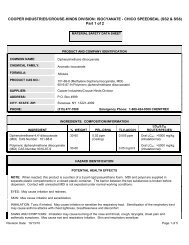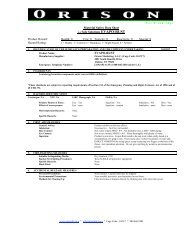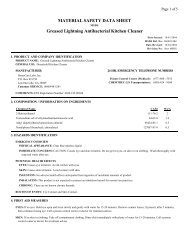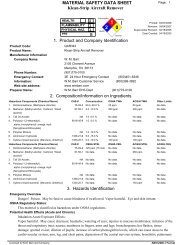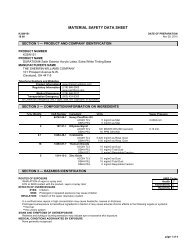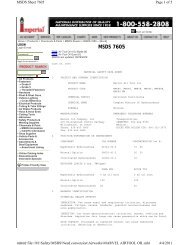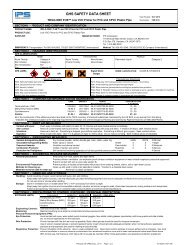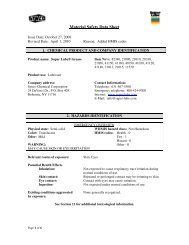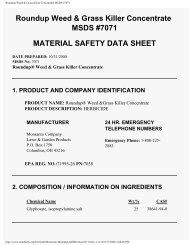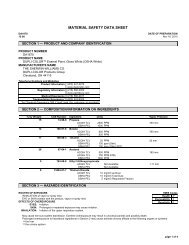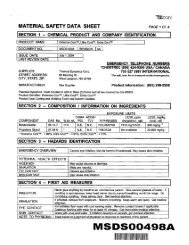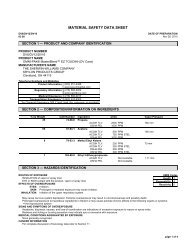MATERIAL SAFETY DATA SHEET - Multi-Craft Contractors, Inc.
MATERIAL SAFETY DATA SHEET - Multi-Craft Contractors, Inc.
MATERIAL SAFETY DATA SHEET - Multi-Craft Contractors, Inc.
Create successful ePaper yourself
Turn your PDF publications into a flip-book with our unique Google optimized e-Paper software.
Class.<br />
5. FIRE-FIGHTING MEASURES (Continued)<br />
UNUSUAL FIRE AND EXPLOSION HAZARDS: This is a Class I-B Flammable Liquid. When involved in a fire, this material<br />
may ignite and produce irritating vapors and toxic gases (e.g., carbon monoxide, carbon dioxide). This material<br />
will readily ignite at room temperature. The vapors are heavier than air and may travel to a source of ignition, and flash back<br />
to a leak or open container. Tetrahydrofuran can form potentially explosive peroxides; closed containers contaminated with<br />
peroxides can rupture violently in the heat of a fire.<br />
Explosion Sensitivity to Mechanical Impact: Not sensitive.<br />
Explosion Sensitivity to Static Discharge: The vapors of this product can be ignited by static electrical energy.<br />
SPECIAL FIRE-FIGHTING PROCEDURES: <strong>Inc</strong>ipient fire responders should wear eye protection. Structural firefighters<br />
must wear Self-Contained Breathing Apparatus and full protective equipment. If it is safe to do so, allow small fires involving<br />
this product to burn-out, while protecting exposures. If possible, prevent runoff water from entering storm drains, bodies of<br />
water, or other environmentally sensitive areas. If necessary, rinse contaminated equipment thoroughly before returning such<br />
equipment to service.<br />
6. ACCIDENTAL RELEASE MEASURES<br />
RELEASE RESPONSE: In case of a spill, clear the affected area and protect people. Uncontrolled releases should be<br />
responded to by trained personnel using pre-planned procedures. Proper protective equipment should be used.<br />
Small releases (e.g., 1-pint) must be cleaned-up by personnel wearing gloves, goggles, and appropriate eye protection.<br />
Face shields must be worn if splashes or sprays of this product may be generated. In the event of a non-incidental release<br />
(e.g., five, 1-gallon containers leaking simultaneously in a poorly-ventilated area), the minimum Personal Protective<br />
Equipment should be Level B: triple-gloves (rubber gloves and nitrile gloves, over latex gloves), chemically resistant<br />
suit and boots, hard-hat, and Self-Contained Breathing Apparatus. Level B should always be used during responses in<br />
which the oxygen level is below 19.5% or unknown.<br />
Eliminate all sources of ignition before spill clean-up begins. Use non-sparking tools. Absorb spilled liquid with activated<br />
carbon, polypads or other suitable absorbent materials. Monitor the area for combustible vapors and the level of oxygen.<br />
Monitoring must indicate less than 10 % of the LEL (see Section 5, Fire-Fighting Measures) and greater than 19.5% Oxygen<br />
is in the atmosphere before personnel are permitted in the area without Level B Protection. Place all spill residue in an<br />
appropriate container and seal. Dispose of in accordance with U.S. Federal, State, or local procedures, the applicable<br />
standards of Canada and its Provinces, or the appropriate requirements of European Community member States (see<br />
Section 13, Disposal Considerations).<br />
PART III How can I prevent hazardous situations from occurring<br />
7. HANDLING and STORAGE<br />
WORK PRACTICES AND HYGIENE PRACTICES: As with all chemicals, avoid getting this product ON YOU or IN YOU.<br />
Wash thoroughly after handling this product. Do not eat, drink, smoke, or apply cosmetics while handling this product. Avoid<br />
breathing vapors or mists generated by this product. Remove contaminated clothing immediately.<br />
STORAGE AND HANDLING PRACTICES: All employees who handle this material should be trained to handle it safely.<br />
Containers of this product must be properly labeled. If this mixture is used in other types of containers, only use portable<br />
containers approved for flammable liquids. Post “NO SMOKING” signs, where appropriate in storage and use areas. Use<br />
non-sparking tools. Bond and ground during transfer of material. Store containers of the product in a cool, dry location, away<br />
from direct sunlight, sources of intense heat, or where freezing is possible. Material should be stored in secondary<br />
containers, or in a diked area, as appropriate. Store containers away from incompatible chemicals. Keep container tightly<br />
closed when not in use. Storage areas should be made of fire-resistant materials. Inspect all incoming containers before<br />
storage, to ensure containers are properly labeled and not damaged. Refer to NFPA 30, Flammable and Combustible<br />
Liquids Code for additional information on storage. Empty containers may contain residual flammable liquid or vapors.<br />
Therefore, empty containers should be handled with care. Do not expose ”empty” containers to welding touches, or any<br />
other source of ignition.<br />
8. EXPOSURE CONTROLS - PERSONAL PROTECTION<br />
VENTILATION AND ENGINEERING CONTROLS: Use with adequate ventilation. Mechanical exhaust may be needed.<br />
Emergency eye-wash/safety showers: where there is any possibility that an employee's eyes may be exposed to this<br />
substance, the employer should provide an eye-wash fountain/safety shower within the work area for emergency use.<br />
LVOC PVC CEMENT PRODUCTS<br />
PAGE 4 OF 11



